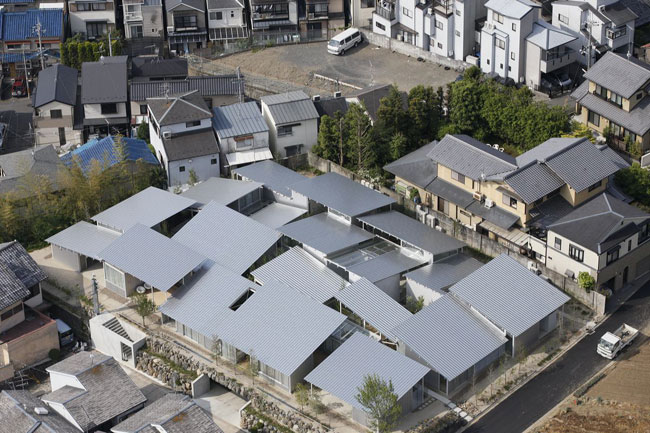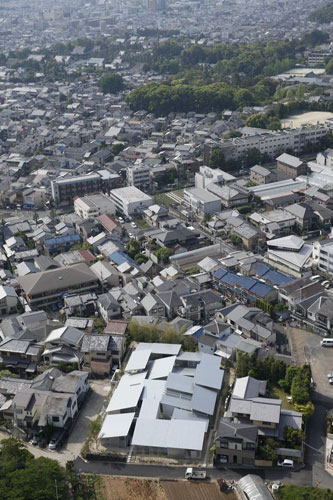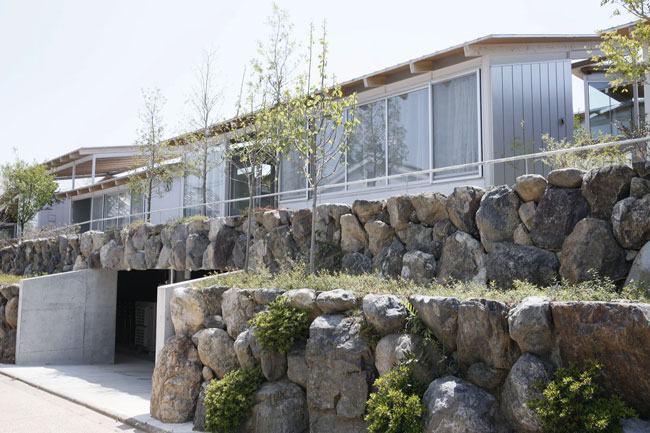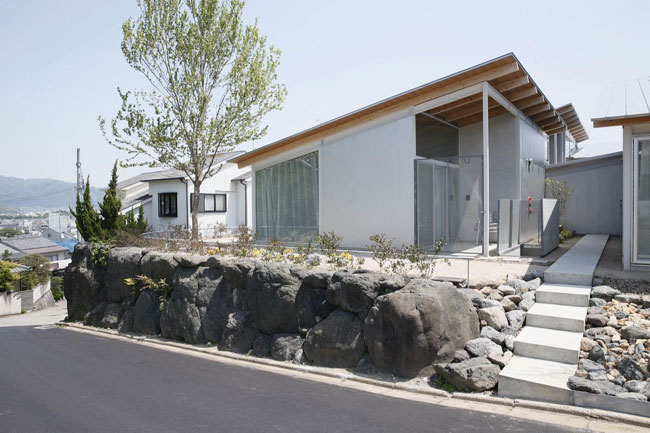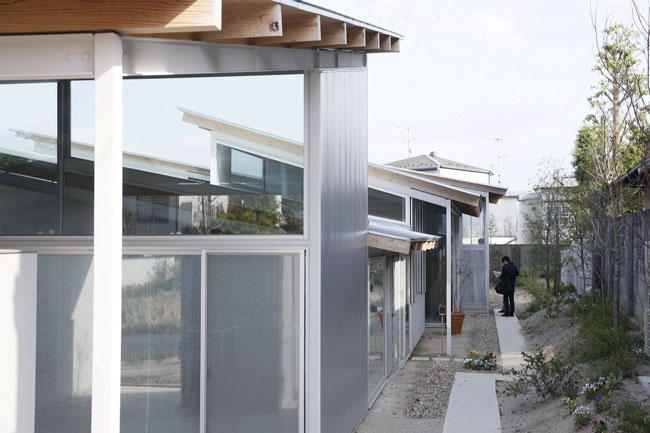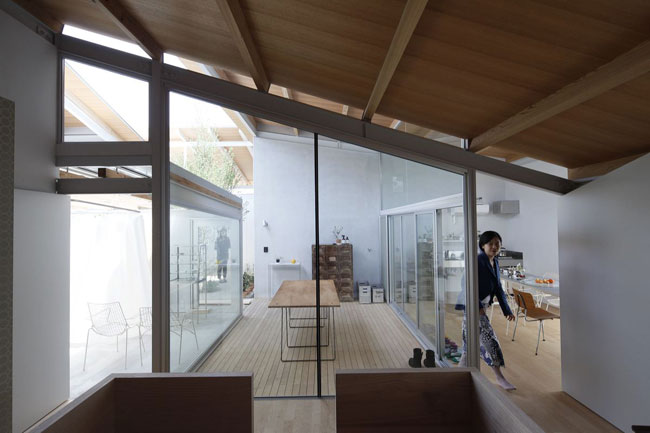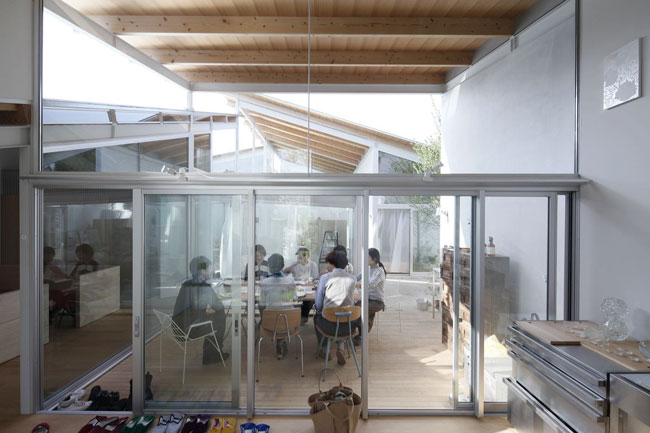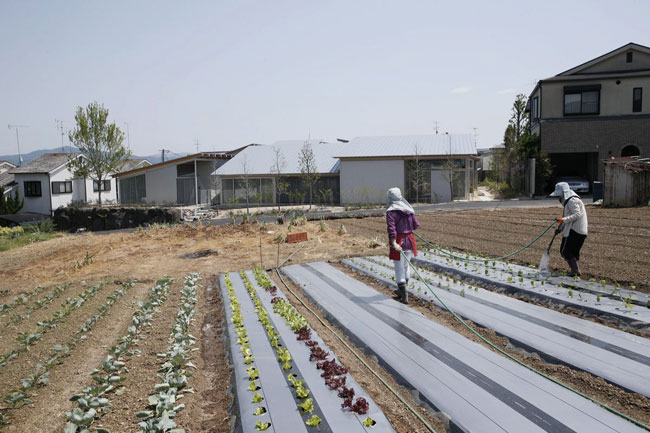Kyoto, Japan
Far from Kyoto’s temples and tourist attractions, the Nishinoyama House sits at the edge of the city surrounded by single-family homes and small agricultural plots. The latest project from the Tokyo architect Kazuyo Sejima, the building contains 10 unique apartments unified by a gridded ground plan and a sequence of overlapping, pitched roofs. Pointing inward and upward, the slanted planes reach their pinnacle at the center of the site. Harmonizing with the architectural vernacular as well as the hilly landscape, they unite the building’s disparate parts into a man-made mound of wood, glass, and steel.
As in many an old community, the dwelling units are both close together and independent of each other. Some of the Nishinoyama apartments share internal walls, roofs and courtyards—Sejima likens them to “communal backyards”—but every home has its own access directly from the site perimeter and some from the underground garage as well. Inside, each apartment is a free-flowing, single-story sequence of multipurpose spaces that connect room to rectilinear room as in a historic Japanese house. Though corridors are absent, some of the apartments include stairs down to a cellar, up to a loft or, in one case, both. While Sejima supplied minimal kitchen accouterments and bathroom fixtures, these elements do not fully dictate room function. In lieu of bathrooms, a few units sequester the tub or toilet in individual enclosures. Elsewhere, the washroom is big enough for chairs and a table as well. “It should be a place to relax,” explains Sejima. (In addition to SANAA, her partnership with Ryue Nishizawa, the architect maintains her independent firm, Kazuyo Sejima & Associates.)
To a large extent the apartment layouts were determined by the 3.28-feet (1-meter) by 2.46-feet (750-centimeter) grid that Sejima applied to the site at the outset of design. Based on the maximum size of a plywood sheet, the grid corresponds with the building’s structure. Instead of supporting the entire complex with a single structural frame, Sejima supplied each apartment with its own localized framing and linked them all together. The result is a unified system composed of discrete parts, each one made up of 3-inch (75-millimeter-square), solid-section steel columns and H-beams that support the wood members securing the plywood roofs. Coupled with steel cross bracing concealed within the building’s mortar walls, the rigid wood sheets counter lateral forces.
In compliance with the municipal code, the 40-room building is capped with 21 slanted planes—Sejima’s first use of pitched roofs. Intended to preserve Kyoto’s picturesque scenery, the regulations also called for 16-inch and 24-inch (40 and 60-cm) deep eaves at the building’s sides and front respectively. Yet, unlike the city’s traditional homes, the Nishinoyama House presents a disjuncture between the housing’s top and bottom. Utilizing a combination of the city’s three acceptable slopes, Sejima covered each unit with three roofs, two shared with the adjacent apartments. “If there were 10 roofs, the project might seem like 10 independent houses, but this is [one] housing [project],” explains the architect. So she connected all of the units with a continuous set of slanted planes.
Similarly, at ground level the floor surface reads as continuous throughout but is composed of stepped planes. Designed to mitigate the site’s 3.3-foot (one-meter) drop spread out along its north-south axis, the floors descend in six-inch (15-centimeter) increments between apartments. Though a construction headache that had to be meticulously worked out in the field, the shifts are barely perceptible. Made of wood, mortar, and tatami, the simple floors complement the galvanized steel cladding the building’s exterior walls as well as the full-height glass and mortar panels serving as its inner faces and interior partitions. While the glass walls, sliding doors, and transom windows enable a close relationship between inside and out, careful positioning of the opaque surfaces minimize direct views between apartments. An abundance of oblique views through the complex, though, enable tenants to sense the presence of others, a desirable feature to many in Japan.
By using elegant and thin components, Sejima has once again succeeded in creating an ethereal work that bears her distinctly light touch. But this building is more than just a sum of clearly articulated parts. As its additive architecture suggests, it is as much a community as it is a housing development.
PeopleSize: 13,563 square feet Construction cost: withheld Completion date: October 2013 |
Products |



















.jpg?height=200&t=1692184429&width=200)
